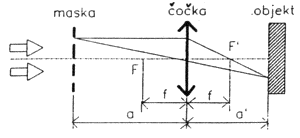TEA CO2 laser parameters and marking application
Introduction
 Fig. 6.1: The scheme of projection by positive lens. The motif from mask (maska) is projected by lens (čočka) to object (objekt). F is the focus, f is focal length, and a is a distance.
Fig. 6.1: The scheme of projection by positive lens. The motif from mask (maska) is projected by lens (čočka) to object (objekt). F is the focus, f is focal length, and a is a distance.Consider lens equation one can derive position of mask for selected magnification as a = f (1+m)
Goal
Measure TEA CO2 laser pulse temporal profile and energy stability. Mark color paper using different mask and different reductions.
Instructions
- Prepare aparatus, i.e.
- switch on power source 24 V / 7 A
- switch on the oscilloscope
- switch on control laptop and run installed control application
- remove the cap from laser output aperture
- Test laser action and verify experiment optical axis.
- Setup beam direction to temporal profile detector input. (approximate distance 1 m)
- Setup the scope to store and memory mode 50 – 100 ns/div.
- Setup the scope triger level to record real optical laser signal (not electrical noise signal)
- Record required temporal profiles and its parameters.
- Insert energy detector into laser beam.
- Setup scope to slow record mode 10 – 20 ms/div.
- Record detector signal on scope and measure its amplitude.
- Setup laser repetition rate to ½ Hz, it is one shot per 2 seconds.
- Record separate peaks amplitude for approx. 100 pulses and evaluate energy stability.
- Calculate distance for proper mask projection, place mask, lens, and object (color paper or paper covered by graphite) and mark it by selected number sequence for three different reductions (m > 2).
Requested results
- The value of FWHM of the first maximum of TEA CO2 laser pulse temporal profile.
- The value of entire width of TEA CO2 laser optical pulse.
- The graph of energy in time and its standard deviation for n measurements, where n is about 100. Optionally add the energy histogram.
- Several successfully marked samples attached to the protocol.
References
- Melles Griot - Transforming a Gaussian Beam with Simple Lenses
- Melles Griot: Transformation and Magnification by Simple Lenses
- Yariv - chapter 7.6 - 7.7
- gas laser theory
Josef Blažej - contact - blazej fjfi.cvut.cz - phone: +420 778 531 895
Czech Technical University in Prague - Faculty of Nuclear Sciences and Physical Engineering
Brehova 7, 115 19 Prague 1, Czech Republic
Czech Technical University in Prague - Faculty of Nuclear Sciences and Physical Engineering
Brehova 7, 115 19 Prague 1, Czech Republic